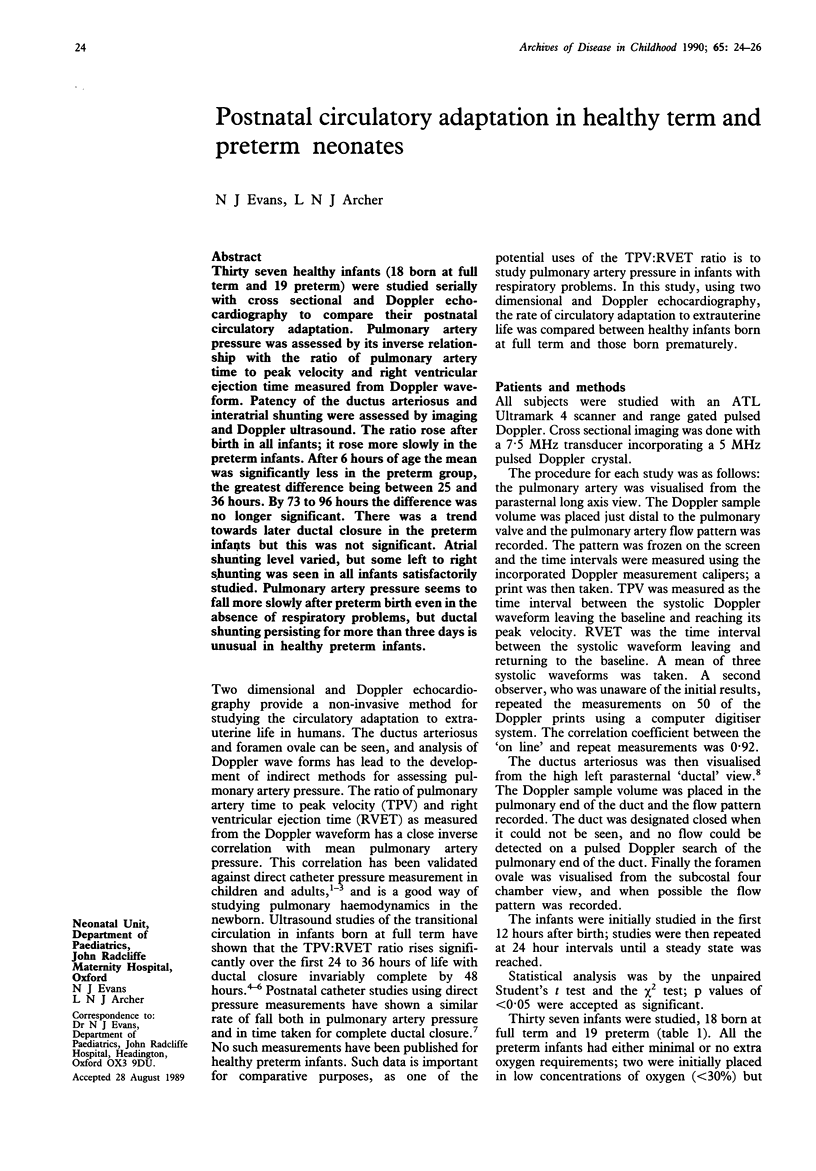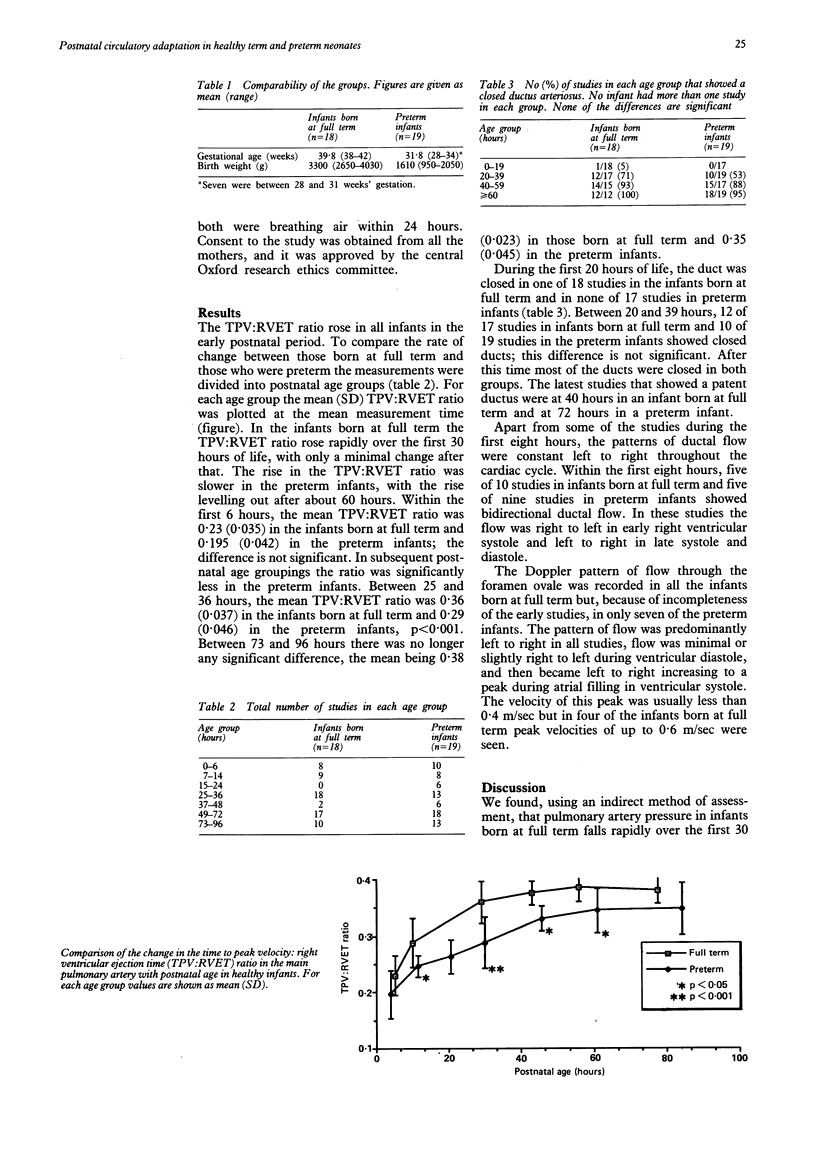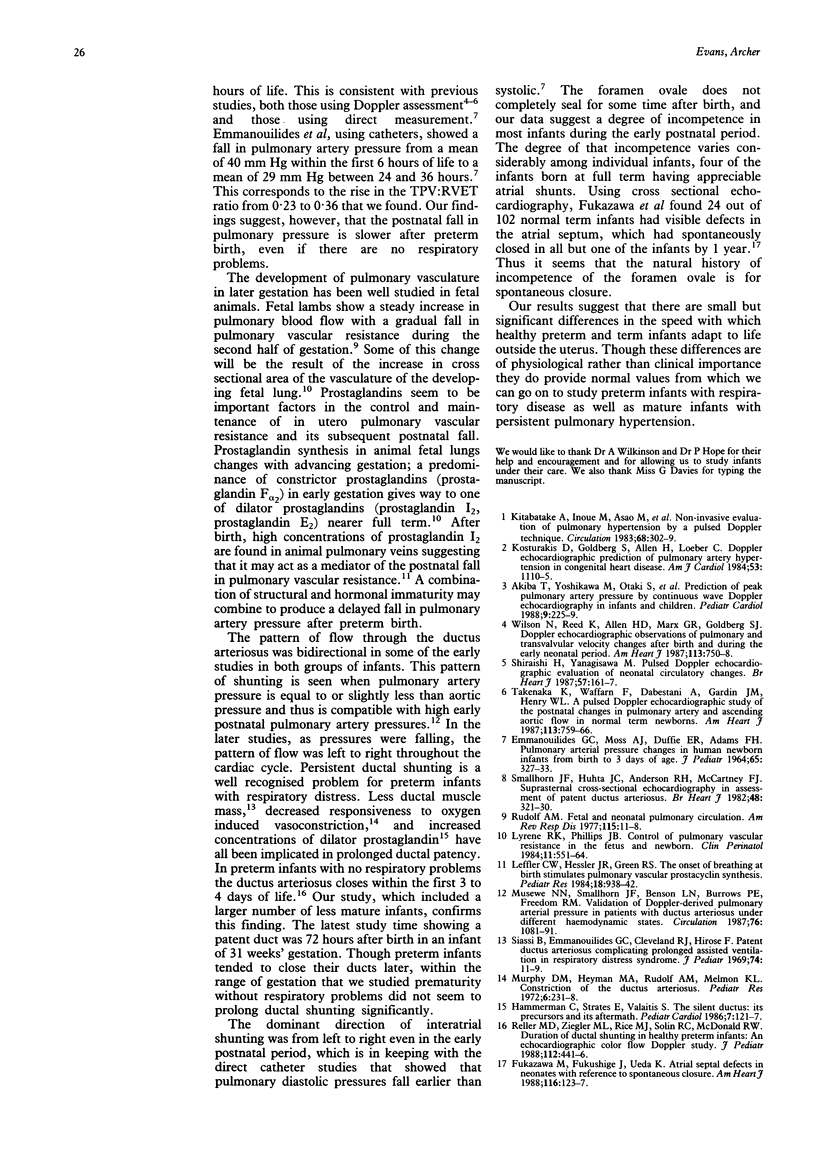Abstract
Thirty seven healthy infants (18 born at full term and 19 preterm) were studied serially with cross sectional and Doppler echocardiography to compare their postnatal circulatory adaptation. Pulmonary artery pressure was assessed by its inverse relationship with the ratio of pulmonary artery time to peak velocity and right ventricular ejection time measured from Doppler waveform. Patency of the ductus arteriosus and interatrial shunting were assessed by imaging and Doppler ultrasound. The ratio rose after birth in all infants; it rose more slowly in the preterm infants. After 6 hours of age the mean was significantly less in the preterm group, the greatest difference being between 25 and 36 hours. By 73 to 96 hours the difference was no longer significant. There was a trend towards later ductal closure in the preterm infants but this was not significant. Atrial shunting level varied, but some left to right shunting was seen in all infants satisfactorily studied. Pulmonary artery pressure seems to fall more slowly after preterm birth even in the absence of respiratory problems, but ductal shunting persisting for more than three days is unusual in healthy preterm infants.
Full text
PDF


Selected References
These references are in PubMed. This may not be the complete list of references from this article.
- Akiba T., Yoshikawa M., Otaki S., Kobayashi Y., Nakasato M., Suzuki H., Sato T. Prediction of peak pulmonary artery pressure by continuous-wave Doppler echocardiography in infants and children. Pediatr Cardiol. 1988;9(4):225–229. doi: 10.1007/BF02078413. [DOI] [PubMed] [Google Scholar]
- EMMANOUILIDES G. C., MOSS A. J., DUFFIE E. R., Jr, ADAMS F. H. PULMONARY ARTERIAL PRESSURE CHANGES IN HUMAN NEWBORN INFANTS FROM BIRTH TO 3 DAYS OF AGE. J Pediatr. 1964 Sep;65:327–333. doi: 10.1016/s0022-3476(64)80395-4. [DOI] [PubMed] [Google Scholar]
- Fukazawa M., Fukushige J., Ueda K. Atrial septal defects in neonates with reference to spontaneous closure. Am Heart J. 1988 Jul;116(1 Pt 1):123–127. doi: 10.1016/0002-8703(88)90259-1. [DOI] [PubMed] [Google Scholar]
- Hammerman C., Strates E., Valaitis S. The silent ductus: its precursors and its aftermath. Pediatr Cardiol. 1986;7(3):121–127. doi: 10.1007/BF02424985. [DOI] [PubMed] [Google Scholar]
- Kitabatake A., Inoue M., Asao M., Masuyama T., Tanouchi J., Morita T., Mishima M., Uematsu M., Shimazu T., Hori M. Noninvasive evaluation of pulmonary hypertension by a pulsed Doppler technique. Circulation. 1983 Aug;68(2):302–309. doi: 10.1161/01.cir.68.2.302. [DOI] [PubMed] [Google Scholar]
- Kosturakis D., Goldberg S. J., Allen H. D., Loeber C. Doppler echocardiographic prediction of pulmonary arterial hypertension in congenital heart disease. Am J Cardiol. 1984 Apr 1;53(8):1110–1115. doi: 10.1016/0002-9149(84)90646-5. [DOI] [PubMed] [Google Scholar]
- Leffler C. W., Hessler J. R., Green R. S. The onset of breathing at birth stimulates pulmonary vascular prostacyclin synthesis. Pediatr Res. 1984 Oct;18(10):938–942. doi: 10.1203/00006450-198410000-00006. [DOI] [PubMed] [Google Scholar]
- Lyrene R. K., Philips J. B., 3rd Control of pulmonary vascular resistance in the fetus and newborn. Clin Perinatol. 1984 Oct;11(3):551–564. [PubMed] [Google Scholar]
- Musewe N. N., Smallhorn J. F., Benson L. N., Burrows P. E., Freedom R. M. Validation of Doppler-derived pulmonary arterial pressure in patients with ductus arteriosus under different hemodynamic states. Circulation. 1987 Nov;76(5):1081–1091. doi: 10.1161/01.cir.76.5.1081. [DOI] [PubMed] [Google Scholar]
- Reller M. D., Ziegler M. L., Rice M. J., Solin R. C., McDonald R. W. Duration of ductal shunting in healthy preterm infants: an echocardiographic color flow Doppler study. J Pediatr. 1988 Mar;112(3):441–446. doi: 10.1016/s0022-3476(88)80333-0. [DOI] [PubMed] [Google Scholar]
- Rudolph A. M. Fetal and neonatal pulmonary circulation. Am Rev Respir Dis. 1977 Jun;115(6 Pt 2):11–18. doi: 10.1164/arrd.1977.115.S.11. [DOI] [PubMed] [Google Scholar]
- Shiraishi H., Yanagisawa M. Pulsed Doppler echocardiographic evaluation of neonatal circulatory changes. Br Heart J. 1987 Feb;57(2):161–167. doi: 10.1136/hrt.57.2.161. [DOI] [PMC free article] [PubMed] [Google Scholar]
- Siassi B., Emmanouilides G. C., Cleveland R. J., Hirose F. Patent ductus arteriosus complicating prolonged assisted ventilation in respiratory distress syndrome. J Pediatr. 1969 Jan;74(1):11–19. doi: 10.1016/s0022-3476(69)80003-x. [DOI] [PubMed] [Google Scholar]
- Smallhorn J. F., Huhta J. C., Anderson R. H., Macartney F. J. Suprasternal cross-sectional echocardiography in assessment of patient ducts arteriosus. Br Heart J. 1982 Oct;48(4):321–330. doi: 10.1136/hrt.48.4.321. [DOI] [PMC free article] [PubMed] [Google Scholar]
- Takenaka K., Waffarn F., Dabestani A., Gardin J. M., Henry W. L. A pulsed Doppler echocardiographic study of the postnatal changes in pulmonary artery and ascending aortic flow in normal term newborn infants. Am Heart J. 1987 Mar;113(3):759–766. doi: 10.1016/0002-8703(87)90717-4. [DOI] [PubMed] [Google Scholar]
- Wilson N., Reed K., Allen H. D., Marx G. R., Goldberg S. J. Doppler echocardiographic observations of pulmonary and transvalvular velocity changes after birth and during the early neonatal period. Am Heart J. 1987 Mar;113(3):750–758. doi: 10.1016/0002-8703(87)90716-2. [DOI] [PubMed] [Google Scholar]


